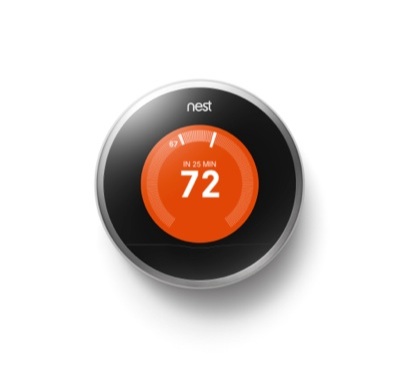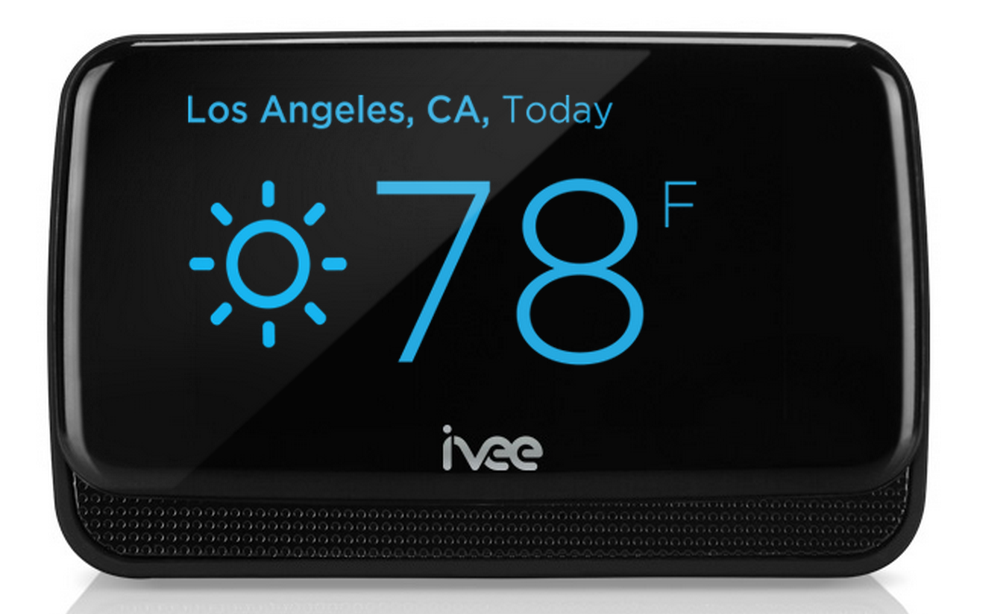Like many of the smart home automation platforms shown at last week’s CES show, Nest Lab’s hot-selling Nest Learning Thermostat runs on embedded Linux. With Google’s pending $3.2 billion acquisition of Nest Labs, the four-year old Palo Alto, Calif.-based firm should enjoy wider distribution and faster product development, while Google gains a foothold in home automation and the Internet of Things (IoT). Yet Google and Nest will be competing with a proliferating array of new products and cross-platform IoT and automation networks, all of which aim to expand by creating ecosystems of compatible wireless-enabled devices.
 Nest’s thermostat was an early entry in a new wave of low-cost, typically Linux-based home automation devices. The category is the result of a confluence of widespread mobile device usage, wider adoption of web APIs and cloud platforms, and lower costs for sensors, wireless chips, and application processors.
Nest’s thermostat was an early entry in a new wave of low-cost, typically Linux-based home automation devices. The category is the result of a confluence of widespread mobile device usage, wider adoption of web APIs and cloud platforms, and lower costs for sensors, wireless chips, and application processors.
Farther below, we look at five more new Linux-based products that similarly start at a few hundred dollars: the Ivee Sleek, Ninja Blocks, BlackSumac’s Piper, Belkin’s WeMo, and WigWag. Like Nest, all of these systems let you remotely interact with a main controller device over web-based cloud platforms via Android and iOS apps to control a variety of household devices.
While the Nest Learning Thermostat controls wireless-enabled “smart grid” heating, ventilation, and air conditioning (HVAC) devices, most of its rivals, such as Belkin’s WeMo, instead focus on lighting. Some interact with smart home appliances, locks, security systems, and even multimedia systems such as the open-API Sonos devices.
Many home automation hubs are designed to support peripheral devices from the same vendor, while also offering support for ecosystems like GE’s smart devices, Philips (Hue), Lowe’s Iris, and Staples Connect. (There was an unconfirmed report that the Iris Hub runs Linux, and that the Staples Connect Hub is based on technology from Zonoff, which offers an open SDK and is seeking developers with Linux experience.)
Each ecosystem shares common wireless protocols and APIs, making it easier for vendors to extend the reach of their automation hubs. As a result, consumers can gradually build their systems a few hundred dollars at a time.
Nest to grow under Google
Despite the competition, Nest Labs looks to have a bright future. It has signed deals with U.S. energy companies and boasts a 25,000+ army of certified installation professionals. Nest’s thermostat has succeeded in the U.S. despite relatively lower energy costs and the end of stimulus spending for smart grid products. Although many analysts believe Google overpaid for Nest Labs, NextMarket projects that the company will go from selling about 100,000 thermostats per month today to an average of 200,000 per month throughout 2014. Google’s acquisition should accelerate the company’s expansion to regions such as Europe, where energy is more expensive and governments subsidize energy efficiency.
Nest’s thermostat appeals to consumers with its refined, Apple-influenced styling — Nest Labs CEO Tony Fadell was the “father of the iPod” and co-founder Matt Rogers was a key iPhone developer — as well as claims that it can reduce a typical energy bill by 20 percent. It also makes it easier to control increasingly high-tech HVAC equipment via WiFi and ZigBee, and it makes on-the-fly adjustments for improved efficiency based on user habits.
While most of the Linux-based products offer open APIs and scripting languages, Nest has yet to open its APIs. That’s more likely to happen under the Google regime, and it’s also likely Nest will introduce some Android devices. A wholesale switch to Android is also possible, but it’s more likely Google will let Nest choose the right open source OS for the job, for example using Android for any new touchscreen based devices. The thermostat already works interactively with Nest’s only other product — the Nest Protect smoke and CO alarm — which runs the open source FreeBSD. Nest could potentially offer a mixed bag of Linux, Android, and open source RTOS devices, all programmable using the same web APIs.
Some have speculated Google will lower the price of the Nest Learning Thermostat, both to grab market share and burnish its “green” image. The $249 price is far more than a dumb thermostat, especially considering owners of larger homes may want more than one. Still, it’s fairly competitive with the five rivals covered below, and it’s downright cheap compared to traditional automation systems that cost tens of thousands of dollars. One of the bigger mid-range platforms is Control4, a Linux-based ecosystem starting at about $1,000 dollars.
A Complex Web of IoT Ecosystems
 Google and Nest will be competing with a growing and overlapping array of Linux-based, or Linux-friendly Internet of Things (IoT) and automation products and frameworks. Some include branded products, such as the GE and Philips Hue ecosystems, or are launched by retailers (Lowe’s Iris and Staples Connect), while others are cross-platform standards.
Google and Nest will be competing with a growing and overlapping array of Linux-based, or Linux-friendly Internet of Things (IoT) and automation products and frameworks. Some include branded products, such as the GE and Philips Hue ecosystems, or are launched by retailers (Lowe’s Iris and Staples Connect), while others are cross-platform standards.
Frameworks include Cisco’s IoT initiative and the Linux Foundation’s newer AllSeen Alliance, based on Qualcomm’s AllJoyn platform. Intel’s Intelligent Device Platform focuses on smart grid intelligent gateway systems, and at CES, Intel unveiled a wearables platform built around its Linux-ready Quark processor and Edison module that could also pop up in home automation.
Other frameworks include Revolv (formerly MobiPlug) and SmartThings, both of which offer a multi-platform approach. Less established are Echelon’s Industrial IoT (IIoT) and Ayla Networks’ Ayla Platform.
At CES, Samsung and LG both announced home automation initiatives built around their ecosystems of smart TVs and appliances. These devices mostly run embedded Linux and/or Linux-based OSes such as Tizen (Samsung), WebOS (LG), or potentially, Android (both). In a critical Jan. 9 analysis of the Samsung and LG initiatives in Ars Technica, Peter Bright suggests the technology will never gel, and argues that IoT is overhyped. “The ‘Internet of things’ stands a really good chance of turning into the ‘Internet of unmaintained, insecure, and dangerously hackable things’,” he writes.
A related issue is privacy — not only from malicious hackers, but from the vendors themselves. In several interviews since Google’s acquisition announcement, Nest Labs’ Fadell stressed that Nest’s strict privacy policy will not change just because the company has been bought by a search and advertising giant.
5 Linux-based Home Automation Systems
The following home automation devices run on Linux, and start at under $300, although many implementations might expand to two or three times that. Like Nest, they enable various home automation and/or security controls via smartphone apps. Most are open source to varying degrees, and started out as crowdfunding projects:
 Ivee Sleek— Ivee’s $200 clock radio device controls smart devices from iControl, Staples Connect, and Lowe’s Iris ecosystems. In addition to mobile app control, the Sleek lets you interact with the hub by voice to control devices. A Siri-like voice assistant answer questions about time, weather, and stocks.
Ivee Sleek— Ivee’s $200 clock radio device controls smart devices from iControl, Staples Connect, and Lowe’s Iris ecosystems. In addition to mobile app control, the Sleek lets you interact with the hub by voice to control devices. A Siri-like voice assistant answer questions about time, weather, and stocks.
Ninja Block Kit— Ninja Blocks’ $199 Ninja Block Kit is built around a BeagleBone SBC and an Arduino-compatible microcontroller. The open source kit provides WiFi control of sensor inputs like motion detectors, contact closures, temperature and humidity sensors, and push buttons. An “API for Atoms” scripting environment can perform functions such as issuing a smartphone alert when the wash cycle is finished.
Piper— Designed primarily for apartment dwellers, BlackSumac’s $209 Piper controller doubles as a security system. Equipped with motion, sound, and temperature detectors, the Piper provides a 180-degree fisheye HD camera with pan and zoom, viewable and controllable via a smartphone. You can control up to 232 devices equipped with the Z-Wave wireless protocol.
WeMo— Belkin’s WeMo has focused on WiFi-equipped light switches, but it also sells a baby monitor and motion detector. At CES, Belkin unveiled an LED lighting set with smart LED bulbs, a smart crock-pot, and a DIY-oriented WeMo Maker Kit that lets you add WeMo capability to other devices. WeMo is increasingly listed as a compatible platform by other automation initiatives.
WigWag — WigWag’s system is built around a Linux-based “Relay” router, as well as Sensor Blocks that run the open source Contiki OS. The Relay supports 6LoWPAN-compatible devices, and lets you add wireless USB dongles supporting WiFi, ZigBee, Z-Wave, or Bluetooth LE. Prices start at $139 for a “Relay” router and a spool of LED lighting to $579 for a set that adds Sensor Blocks. The latter include humidity, temperature, sound, vibration, motion, contact, and ambient light sensors, as well as an IR receiver and electronic relays for controlling garage doors and sprinkler systems. An open source development kit is built around DeviceJS.


